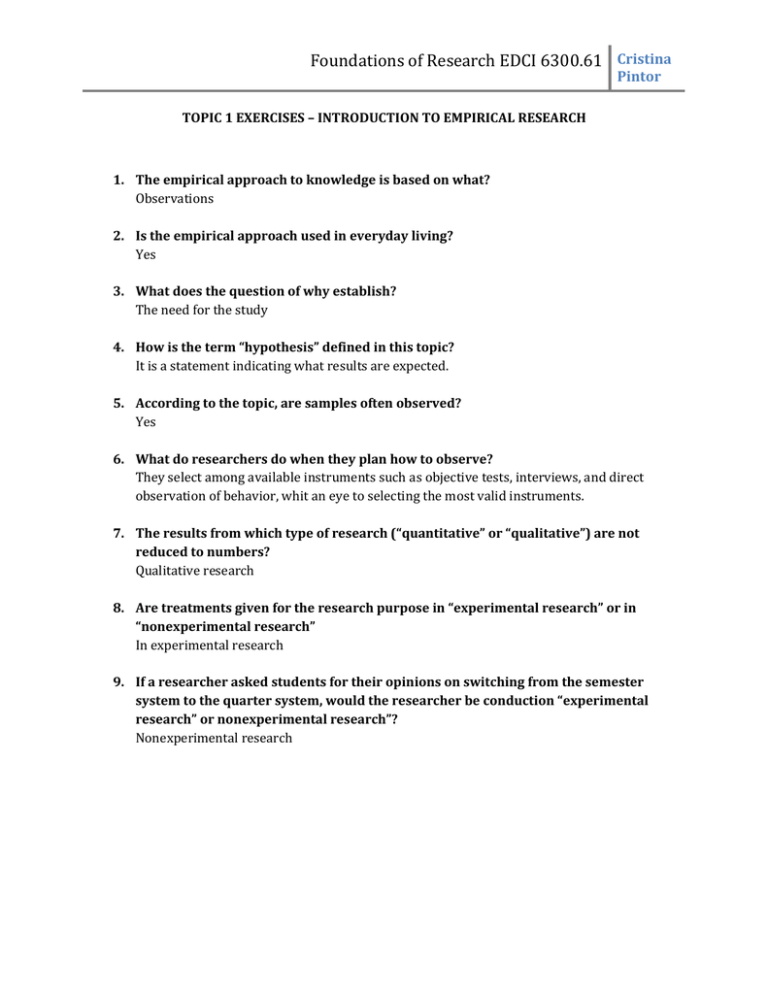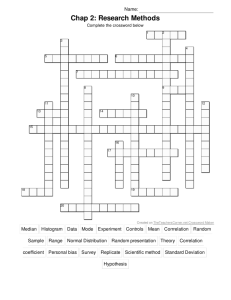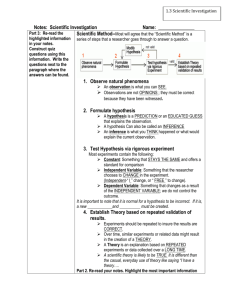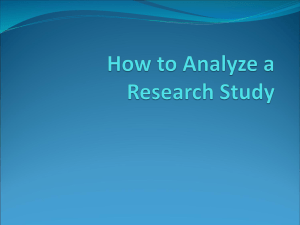Foundations of Research EDCI 6300.61
advertisement

Foundations of Research EDCI 6300.61 Cristina Pintor TOPIC 1 EXERCISES – INTRODUCTION TO EMPIRICAL RESEARCH 1. The empirical approach to knowledge is based on what? Observations 2. Is the empirical approach used in everyday living? Yes 3. What does the question of why establish? The need for the study 4. How is the term “hypothesis” defined in this topic? It is a statement indicating what results are expected. 5. According to the topic, are samples often observed? Yes 6. What do researchers do when they plan how to observe? They select among available instruments such as objective tests, interviews, and direct observation of behavior, whit an eye to selecting the most valid instruments. 7. The results from which type of research (“quantitative” or “qualitative”) are not reduced to numbers? Qualitative research 8. Are treatments given for the research purpose in “experimental research” or in “nonexperimental research” In experimental research 9. If a researcher asked students for their opinions on switching from the semester system to the quarter system, would the researcher be conduction “experimental research” or nonexperimental research”? Nonexperimental research Foundations of Research EDCI 6300.61 Cristina Pintor TOPIC 2 EXERCISES – EXPERIMENTAL VERSUS NONEXPERIMENTAL STUDIES 1. Are treatments given in nonexperimental studies? No 2. In an experiment, Group A was given verbal praise for being on time for appointments while Group B was given no special treatment. Which group is the control group? Group B 3. Is it necessary to have at least two groups of participants in order to conduct an experiment? No 4. What is the purpose of a nonexperimental study? To observe participants in order to describe them as they naturally exist without experimental treatments. 5. Is a survey an experiment? No 6. Does anyone knowing that a multiple choice test was used in a study help a consumer of research determine whether the study was experimental or nonexperimental? No 7. What is the purpose of an experiment? To explore cause-and-effect relationships. 8. A political scientist polled voters to determine their opinions on a decision by the Supreme Court. Is this an “experimental study” or a “nonexperimental study”? Nonexperimental study 9. A teacher compared the effectiveness of three methods of teaching handwriting by using different methods with different students. Did the teacher conduct an “experimental study” or a “nonexperimental study”? Experimental study Foundations of Research EDCI 6300.61 Cristina Pintor TOPIC 3 EXERCISES – EXPERIMENTAL VERSUS CASUAL-COMPARATIVE STUDIES 1. According to the topic, do “experimental” or “casual-comparative” studies have more potential pitfalls when one is trying to identify cause-and-effect relationships? The casual-comparative study 2. Researchers look to the past for a cause in which type of study? The casual-comparative study 3. Is casual-comparative research a type of experiment? No 4. Are treatments given by researches in casual-comparative studies? No 5. Random assignment to treatments is used in which type of study? Experimental study 6. How is the term demographics defined in this topic? Background characteristics such as socioeconomic status 7. A researcher compared the health of low-income adolescents who had received free lunches during the elementary school years with the health of a comparable group of low-income adolescents who had not received free lunches. The purpose was to determine the effects of free lunches on health. Did the researcher conduct an “experimental” or a “casual-comparative” study? Casual-comparative study 8. A researcher divided patients with diabetes who were being released from the hospital into two groups. Upon their release, the researcher provided brief counseling for individuals with diabetes to one group while providing the other group with extended counseling, The purpose was to determine the effects of the two types of counseling on patients’ compliance with physicians’ directions during the first month after hospitalization. Did the researcher conduct an “experimental” or a “casual-comparative” study? Experimental study 9. What is another name for the term casual-comparative study? Ex post facto study Foundations of Research EDCI 6300.61 Cristina Pintor TOPIC 4 EXERCISES – TYPES OF NONEXPERIMENTAL RESEARCH 1. Suppose a researcher administered an intelligence test to young children each year for five years in order to study changes in intelligence over time. The researcher was conducting what type of study? Longitudinal research 2. Is the study in Question 1 experimental? No 3. If a researcher conducts a poll to estimate public support for free childcare for mothers on welfare, the researcher is conducting what type of nonexperimental study? Survey research 4. A researcher determined the degree for relationships between vocabulary scores and reading comprehension scores. The researcher was conducting what type of nonexperimental study? Correlation research 5. According to this topic, what is a distinctive feature of quantitative research? That the researchers gather data in such a way that the data are easy to quantify. 6. Most published qualitative research is collected using what? Semi structured interviews in such in which there is a core list of questions from which the interviewers may deviate as needed to obtain in-depth information. Foundations of Research EDCI 6300.61 Cristina Pintor TOPIC 5 EXERCISES – VARIABLES IN NONEXPERIMENTAL STUDIES 1. Adults who were taking a course to learn English as a second language were asked to name their country of birth and their number of years of formal education. In this example, how many variables were being studied? Two variables (country and number of years of formal education) 2. In question 1, which variable is a categorical variable? Country of birth 3. In question 1, which variable is quantitative? Number of years of formal education 4. A sample of adults was asked their level of agreement with the statement “The President of the United States is doing a good job of handling foreign relations”. They were allowed to respond with either “strongly agree”, “agree”, “disagree” or “strongly disagree”. How many variables were being studied? One 5. What is meant by mutually exclusive categories? It is when each respondent to the survey will belong to one and only one category. 6. A researcher looked for the causes of social unrest by examining economic variables such as poverty, income, and so on. Is social unrest an “independent” or a “dependent” variable? Dependent variable 7. If a researcher administers a basic math test to middle school children to see if the basic math test scores predict grades in high school algebra, what is the criterion variable? High School Algebra grades 8. Suppose a researcher asks participants to identify their age group using these categories: “under 21” , “21-39”, “40-55”, and “56+”. Are these exhaustive categories? Yes, because it includes a category for each responder 9. In question 8, how many variables are being studied? One 10. What is the minimum number of categories that each variable must have? Two Foundations of Research EDCI 6300.61 Cristina Pintor TOPIC 6 EXERCISES – VARIABLES IN EXPERIMENTAL STUDIES 1. All experiments have at least how many dependent variables? One 2. In an experiment, what is the name of a stimulus or input variable? Independent variable 3. What does physically manipulate mean in an experimental context? To physically administer treatments 4. Are dependent variables physically manipulated? No 5. Can an experiment have more than one independent variable? Yes 6. Every other customer entering a shoe store was given a different coupon. One coupon offered a second pair of shoes for 50% off. The other coupon offered to reduce the total price by 25% if two pairs of shoes were purchased. The purpose was to determine which coupon was more effective in getting individuals to buy two pairs of shoes. In this experiment, what is the independent variable? Coupons 7. In question 6, what is the dependent variable? If two pairs of shoes were purchased 8. A teacher showed an educational film on daily nutritional needs to one group of students and gave a handout on the same material to another group. The purpose was to determine which method of instruction was more effective in increasing students’ knowledge of daily nutritional needs. In this experiment, what is the dependent variable? Students’ knowledge of daily nutritional needs 9. In question 8, what is the independent variable? The film and the Handout Foundations of Research EDCI 6300.61 Cristina Pintor TOPIC 7 EXERCISES – RESEARCH HYPOTESES, PURPOSES, AND QUESTIONS 1. Which type of statement (hypothesis, purpose or question) predicts the outcome of a study? Hypothesis 2. “It is hypothesized that college students who have firm career goals achieve higher GPAs than those who do not have firm career goals”. Is this a “directional” or a “nondirectional” hypothesis? Directional hypothesis 3. “It is hypothesized that children of immigrants and children of native-born citizen differ in their attitudes toward school”. Is this a “directional” or a “nondirectional” hypothesis? Nondirectional hypothesis 4. “The goal of this study is to examine college students’ attitudes toward religion” Is this statement a “hypothesis” or a “purpose”? Purpose 5. “Are children of alcoholics different from children of nonalcoholics in their social adjustment?” Is this research question stated appropriately? Why? Why not? No, because it can be answered with a yes or no. 6. When researchers are willing to predict the outcome of a study, should they state a “directional” or a “nondirectional” hypothesis? Directional hypothesis 7. What are the two alternatives to stating a nondirectional hypothesis? Research purpose or research question 8. Consider nondirectional hypotheses, research purposes, and research questions. Are “all three acceptable in the scientific community” or is “one type preferred over the others”? All three are accepted





